![]()
Aroids and other genera in the Collection
Take the Tour Now?
Orchids
The
Exotic Rainforest
Plants in
the Exotic Rainforest Collection
Images on this website are copyright protected. Please contact us before attempting
to reuse.
Anthurium regale
Linden
Growth of an
inflorescence
Please note:
This page contains numerous photographic images.
If you are using a dial-up connection the time may be longer
than expected.
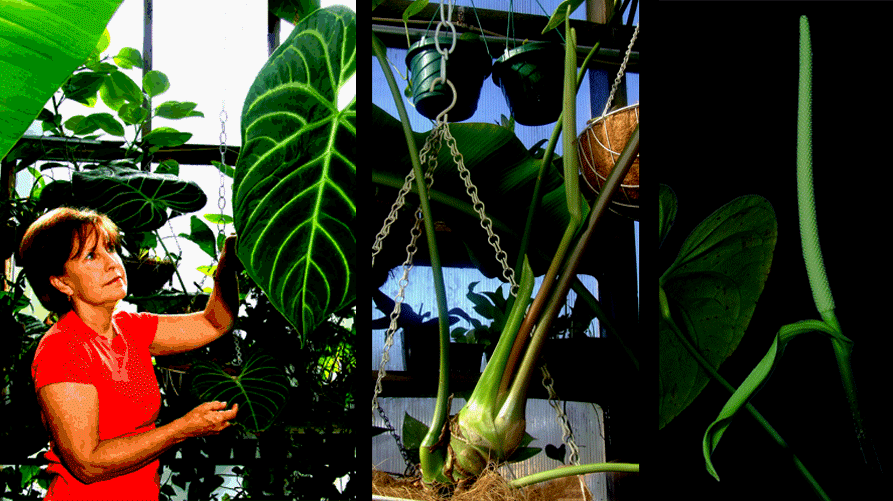
Photos ©
2006/2007 Steve Lucas
Growth of an inflorescence
To read our observations regarding this species click on this link: Anthurium regale.
To advance to Day 17 to 31 Click Here
The part of the stamen where the pollen is produced and contained
The period during which a flower is fully open and functional. The time of pollination or bloom.
A group or cluster of flowers on a branch of a plant, in botany used to describe the structure of a spathe and spadix
Infructescence -
(in-fruc-TES-sence)
The fruiting
stage of an inflorescence
Nectar - (NEC-tar)
The exudate
produced by the spadix in to attract pollinators
Perigone -
(PERU-gown)
Collective term for the outer parts of a flower (parts of the spadix in
this case) enclosing the stamens and pistils
A scent produced by the spadix during anthesis to attract insect pollinators and distribute pollen.
Pistil - (PIS-til)
sometimes incorrectly called flower sperm, is a fine to coarse powder consisting of pollen grains which produce the male
gametes (sperm cells) of seed plants
Male reproductive parts of a flower
Stigma - (STIG-ma)
The pollen receptive surface, usually sticky, where the
pollen enters the pistil. Usually the stigma will bear a sweet
solution
which can attract insects to the sticky surface of the
stigma where pollen is received and on which pollen
germinates
Stigmatic Hairs (stig-MAT-ic)
Hairs at the end of the stigmas designed to entrap the pollen grains. These
trichomes may also induce germination of the pollen grains.
The photos on this page are the documentation of the
development of our first inflorescence (spathe and spadix)
on
our specimen
of Anthurium regale.
The specimen was acquired in September, 2005. It had no leaves and was
small when it arrived. Unlike descriptions I've sometimes read on the
internet which claim A. regale is a slow
grower, during the first 14 months of growth the plant
grew rapidly and
produced 5 leaves,
one of
which was
accidentally destroyed. In mid December 2006 I began to notice what
I thought was the
development
of
a 6th new
leaf. Since the production of a spathe is apparently not common
for this species
in
cultivation I was
not expecting an
inflorescence.
However, I did note the new growth was
not forming as
previous leaves had formed. Instead it
formed directly alongside the
last large petiole which had grown
just
6
weeks before. That last leaf measures
73cm (29 inches)
and the
petiole is 90cm (3 feet) long. I was
excited
about
the prospect of the next leaf since
each leaf has been
larger than the last. I was even more
excited to see
the
new "leaf" was not a leaf, but instead
a spathe and
spadix.
The entire spathe and
peduncle measured 38cm
(15 inches) from the base to the top of
the
spathe.
This is simply a personal observation, but it is my believe the plant grew
quickly and has produced
this
inflorescence within the first 14 months of growth due to the
conditions in our atrium. We maintain
filtered light
with a humidity level of 85% + at all times. The
temperatures are moderate most of the year.
As a result, our
conditions closely match the natural growing conditions the
plant experiences in Peru.
seen on that day. Although difficult to see in the first photograph the spadix is just beginning to be seen near the
top of the spathe. The spathe measures 20cm (8 inches). In the second photo you can just begin to see the spadix
at the top 5cm (2 inches) of the inflorescence on day 2. The spathe has begun to open
slightly more.
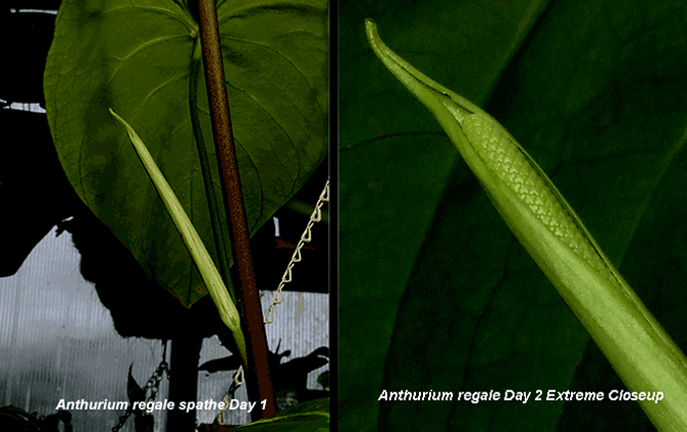
be receptive. However, since I do not have a source of pollen, there is no way to pollinate the spadix, thus producing seeds. I'm frantically doing research. One knowledgeable grower has suggested it may be possible to remove the
entire spadix to refrigerate it for pollination of the next inflorescence. Julius Boos has recommended letting it play out
and attempting to collect pollen with a camel hair brush. At this point, I've elected to simply track the growth, attempt to collect pollen, and record it photographically. I've located another semi-large plant and will be adding it to the collection very soon in to increase the odds of having pollen the next time this occurs.
"It will be difficult to get pollination from one spadix because typically the plants are very protogynous and pistillate flowers
are no longer functional when the pollen is fresh." "Protogynous" indicates the plant functions first as a female producing receptive flowers, then as a male producing pollen.
continues, "Telling when a particular Anthurium inflorescence is ready for pollination is a very easy matter. The stigma will exude a drop of fluid which will sit at the apex of each individual flower on the spadix. Some species present this droplet on all flowers at the
same time and others may present theirs in succession. This usually takes place in the early morning hours. At any rate when
these droplets are present, the flower is 'ready' to be pollinated.
closely as my glaucoma ridden eyes will allow for any sign of female anthesis.
near the top. Approximately 4cm (1 5/8th inches) is now exposed.
 Since I've done all I can to
duplicate the plant's natural conditions (read the main article) my goal is
to be able
to
eventually pollinate Anthurium regale and produce
seeds. At this point I have elected to simply observe
and
Since I've done all I can to
duplicate the plant's natural conditions (read the main article) my goal is
to be able
to
eventually pollinate Anthurium regale and produce
seeds. At this point I have elected to simply observe
and photograph this event. I have located another plant which will be in the atrium in about 10 days (early January 2007). That could easily take one year to produce a 2nd spathe. If there are growers out there who have an
Anthurium regale about to bloom or if you have pollen stored for this species I'd love to hear from you.
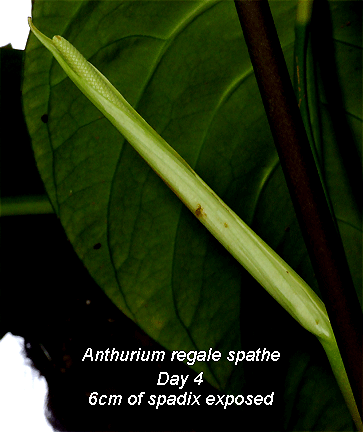

Day 4: approximately 6cm (2 3/8ths
inches) of spadix is
exposed. No evidence of anthesis can yet be seen.
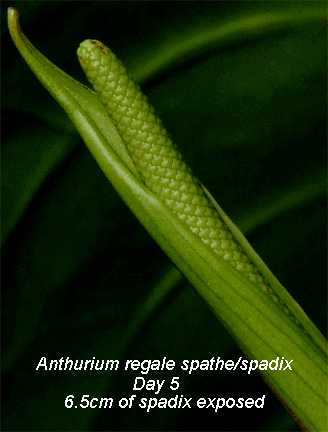
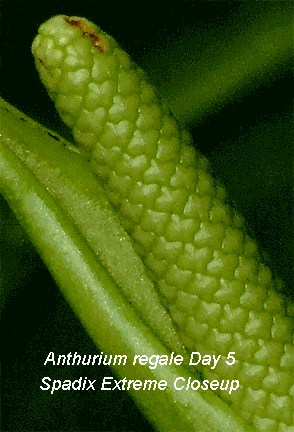
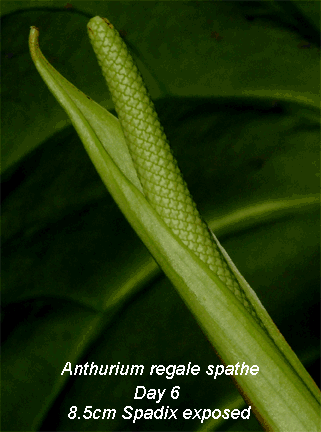
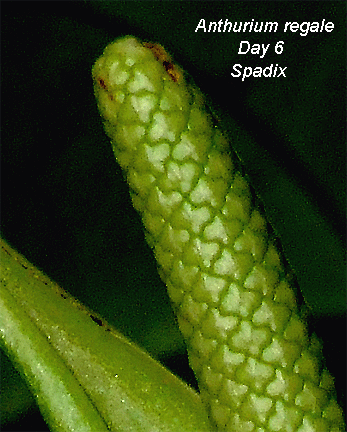

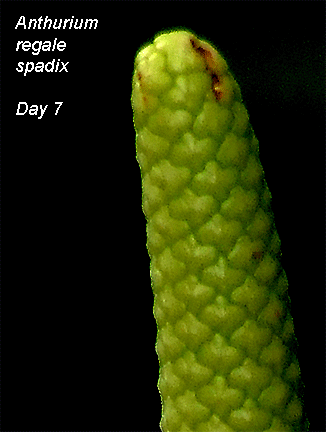
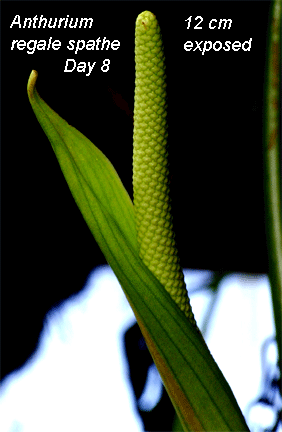
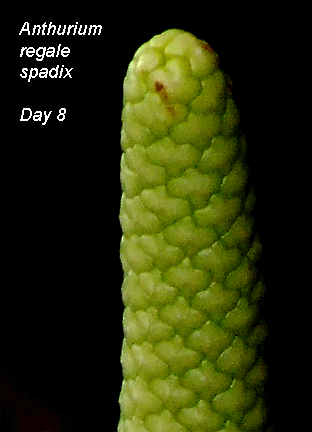
along with me this narration was provided by Julius Boos. Julius is not a botanist, but he should have been!
to explain what we are all seeing happen, "imagine a hen's egg with a small 'nipple' at the top. (Look at the
visible/protruding, and with a tiny drop of liquid at its tip when at the peak of female anthesis. The pollen adheres to the
liquid on the stigma, and grows down a path to fertilize the ovules. This anthesis seemingly has not occurred as yet in
your plant, as your stigmas at this stage and in your photos are visible only as a tiny raised point/dot at the very center
of each segment."
'egg', they extend up and around/along its sides, sort of embracing the 'egg', curving over and partially covering the top
They show on your photo as the little 'squares' or 'scollops' around each individual 'egg' and stigma, but because your
flowers are still developing, you are having difficulty seeing where the edges of the perigone segments end and at their
edges overlap on top of the 'egg'."
attempting to reproduce itself. Hopefully, all of us can learn something from the exercise.
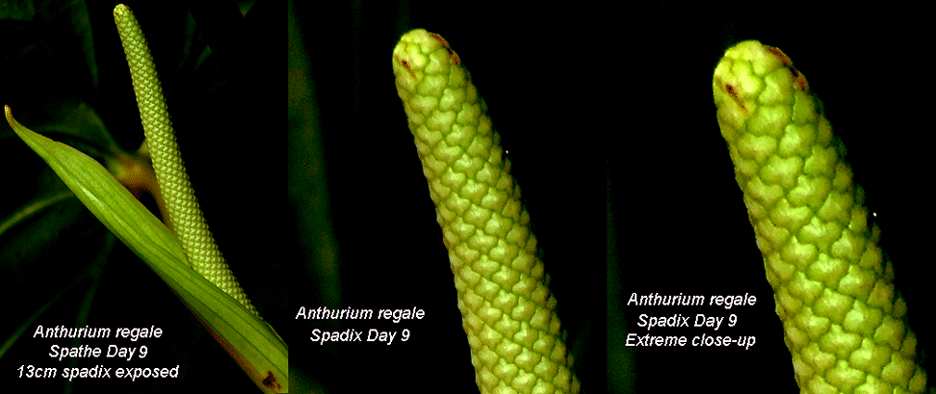
The spadix in the first photo is near life size.
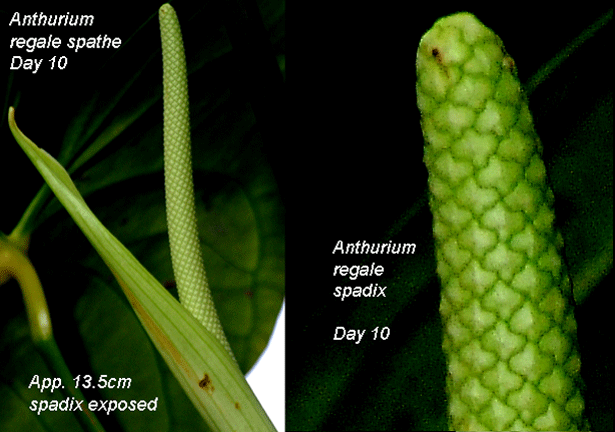
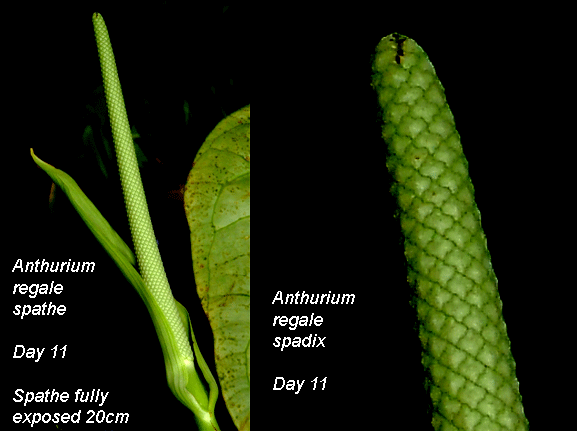
an email this morning with more insight. Julius said, "the spathe will probably reflex (turn away from pointing forward
and face backward on itself) when the spadix goes into anthesis, or immediately before, leaving the spadix standing
completely exposed.
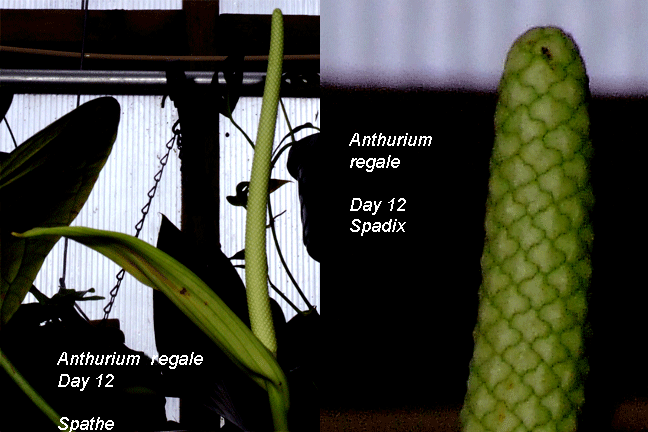
be imminent. The spathe itself measures 20cm (8 inches).
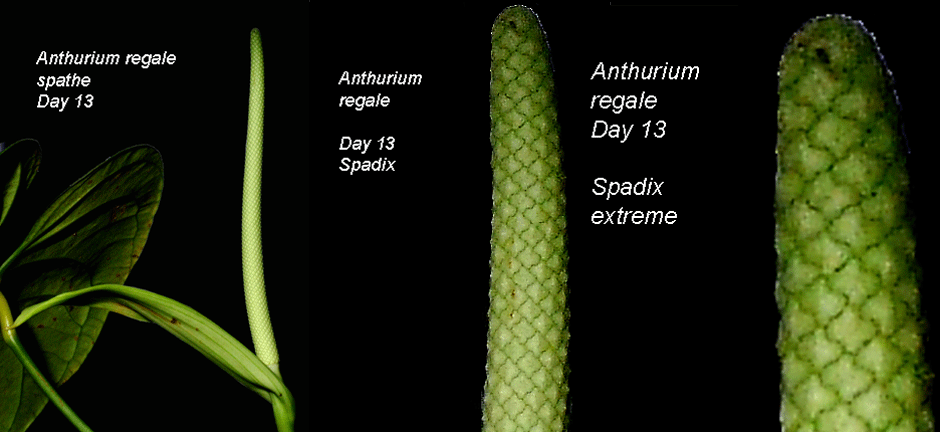
Day 13: Both day 12 and day 13 the weather has been extremely overcast making quality photography difficult.
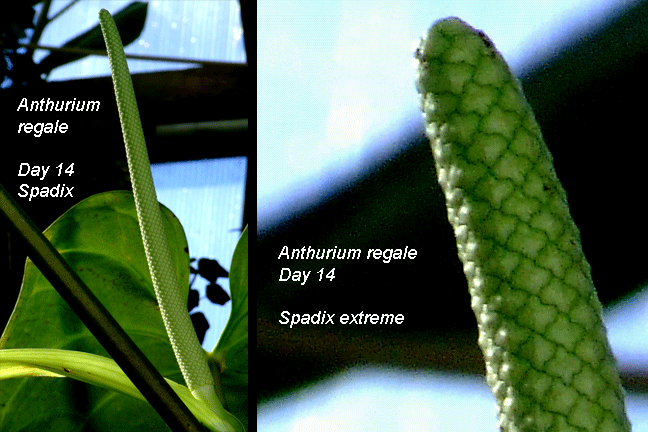
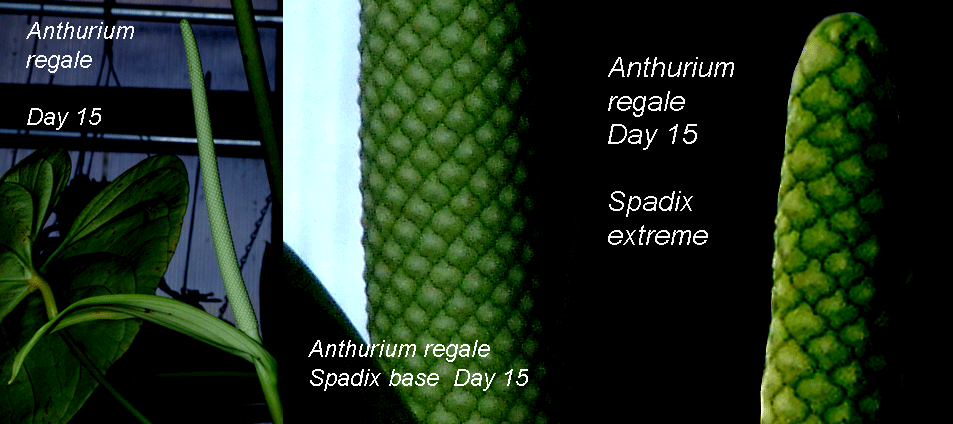
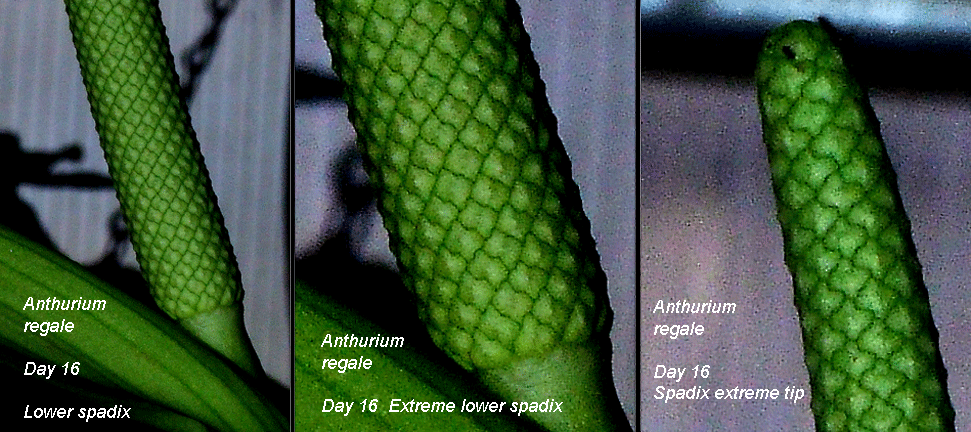
Day 16: Although the "nipples" of the florets appear somewhat enlarged no evidence can be seen of an exudate.
However, there are more experienced eyes in the world of botany! Today Dr. Croat wrote: "I can clearly see the pistils exposed on the lowermost flowers so it is possibly capable of being pollinated but usually there is a more evident sign that it is receptive. Frequently the stigmas form a clear droplet of a sugary solution. These may swell until the drip off the spadix if no pollinator is removing the solution. For some species no accumulation is ever evident and itstead the stigmas become glistening, which also signifies receptivity. This condition is harder to detect but if you are watching this daily you should have no problem recognizing receptivity. Another sure sign of receptivity is scent so smell the spadix each day. Many Anthurium have very distinct scents, attracting specific pollinators and the scents are wildly variable, ranging from perfume-like to yeast-like or scents of spoiling fruits. I once had a student studying the quality of the nectar and this is also variable in terms of quantity of nectar produced and the content of the nectar, percentage of sucrose, dextrose, fructose, glucose, etc. Despite having 1000 to 1500 species we know next to nothing about the pollination systems of Anthurium.
It would be a great area of study for a very patient observer."
in to tell the story while allowing those with a dial-up connection to the photographs.
You are currently on Page 2
Click the appropriate link: